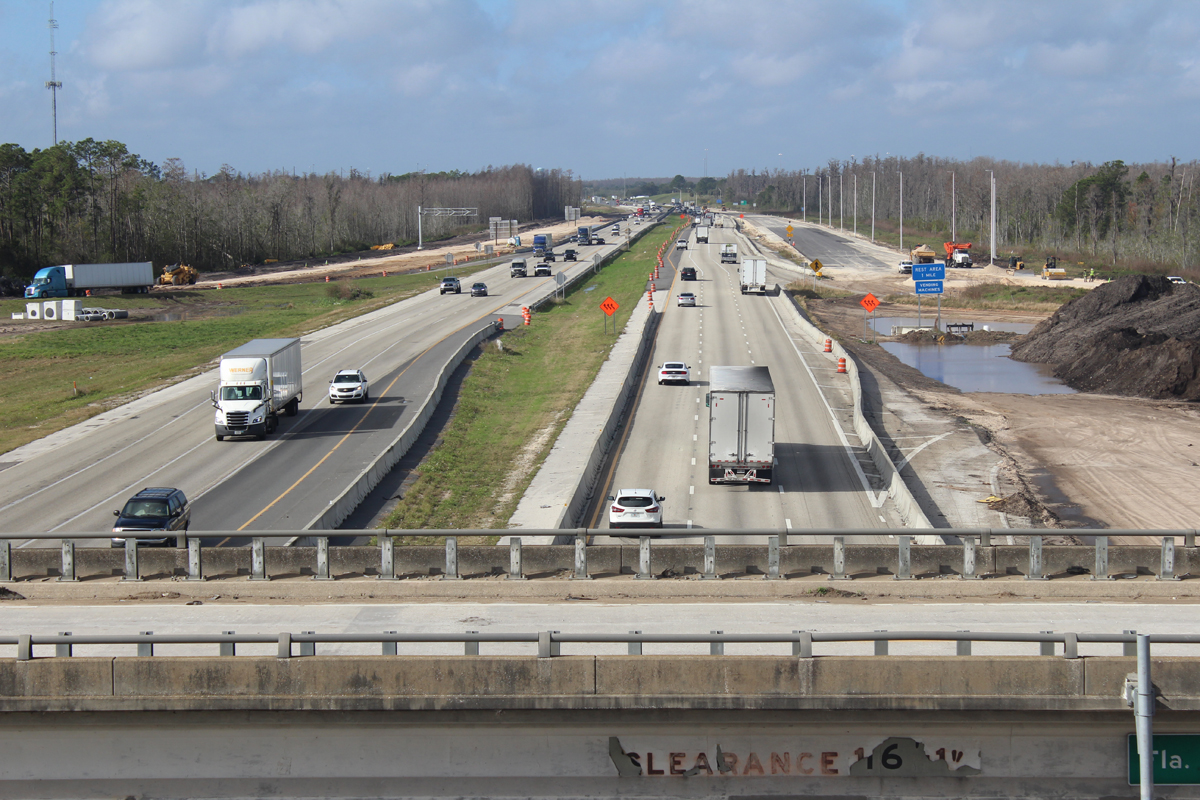
ORLANDO, Fla. — Brightline has petitioned the Florida Development Finance Corp., seeking to have the state agency issue up to $400 million of private activity bond funding to advance design and planning for its long-sought extension to Tampa, as well as improvements to existing routes.
The request for more debt financing comes as the company plans to defer a scheduled July 15 payment to current bondholders, who have been earning 10% to 12% on their private activity bond investment.
Meanwhile, a Trains News Wire analysis shows these financial events are occurring at a time when benefits of increased capacity are starting to extricate Brightline from its previous inability to capture increased demand for both Miami-Orlando and South Florida travelers created by its superior onboard service, reliability, and 16 daily round trips. The expanded capacity has come with the addition of a Smart class coach on every train.
New bonds
The FDFC announced a public hearing will be held via telephone on Thursday, July 17, beginning at 2 p.m. EDT. The notice, including dial-in instructions, explains the funds generated from bond sales could also be used for enhancements to existing operations.
In addition to Tampa route investments, initiatives listed in the notice include improvements to the single-track St. Lucie River draw bridge at Stuart, Fla., as well as proposed infill stations there and in Brevard County at Cocoa, where the east-west airport line diverges from Florida East Coast’s north-south main. Brightline was turned down for federal Consolidated Rail Infrastructure and Safety Improvement grants for those projects in 2024, but the operator and communities continue to pursue other grants to augment company and local financing.
Delayed payments
Private activity bonds have been a key financing component for both Brightline and Brightline West. Their sales to investors are predicated on the fact that buyers believe future operating cash flow running passenger trains and reaping benefits of real estate investments will be sufficient to pay off construction debt. As originally reported by Bloomberg News last week, the company advised bondholders that it would fail to make an interest payment set for July 15.
In follow-up reporting by the South Florida Sun Sentinel in a paywalled story, Brightline said the late payment was allowed under the terms of the bond issue and it “intended to make the deferred interest payment with operating cash flow or proceeds from equity and debt financings we are actively pursuing.” Under those terms, once payments are made, the company will add 2% to the rates bondholders expect to receive.
In 2024, Brightline ran an operating deficit, excluding interest payments, of $153 million on revenues of approximately $188 million. Including those payments, the 2024 quarterly loss averaged about $140 million, but that dropped to $60 million in first quarter 2025.
Analyzing ridership and revenue
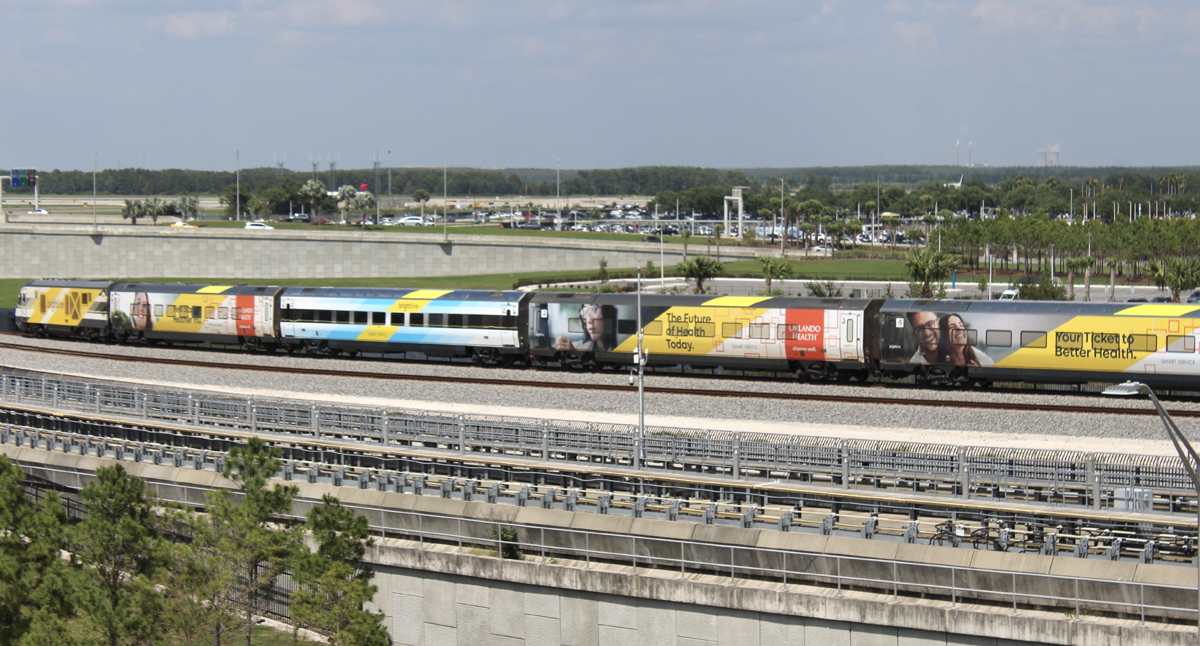
The reason for the improvement is that instead of three Smart class coaches and one Premium car on each train, the consists were expanded in mid-2024 to include additional Smart coaches. This was meant to counteract a capacity crunch that led Brightline to sharply raise fares on West Palm Beach-Miami commuters, with monthly passes jumping from $10 to $35 per ride. This was to open up room on its trains for high-revenue South Florida-Orlando travelers. Until additional deliveries arrived from Siemens, the expanded consists meant frequencies had to be reduced, which in turn left fewer opportunities to capture Premium class customers.
The comparison below of May 2024 and May 2025 results shows how the company continues to make incremental gains with more capacity while temporarily sacrificing some hourly frequencies.
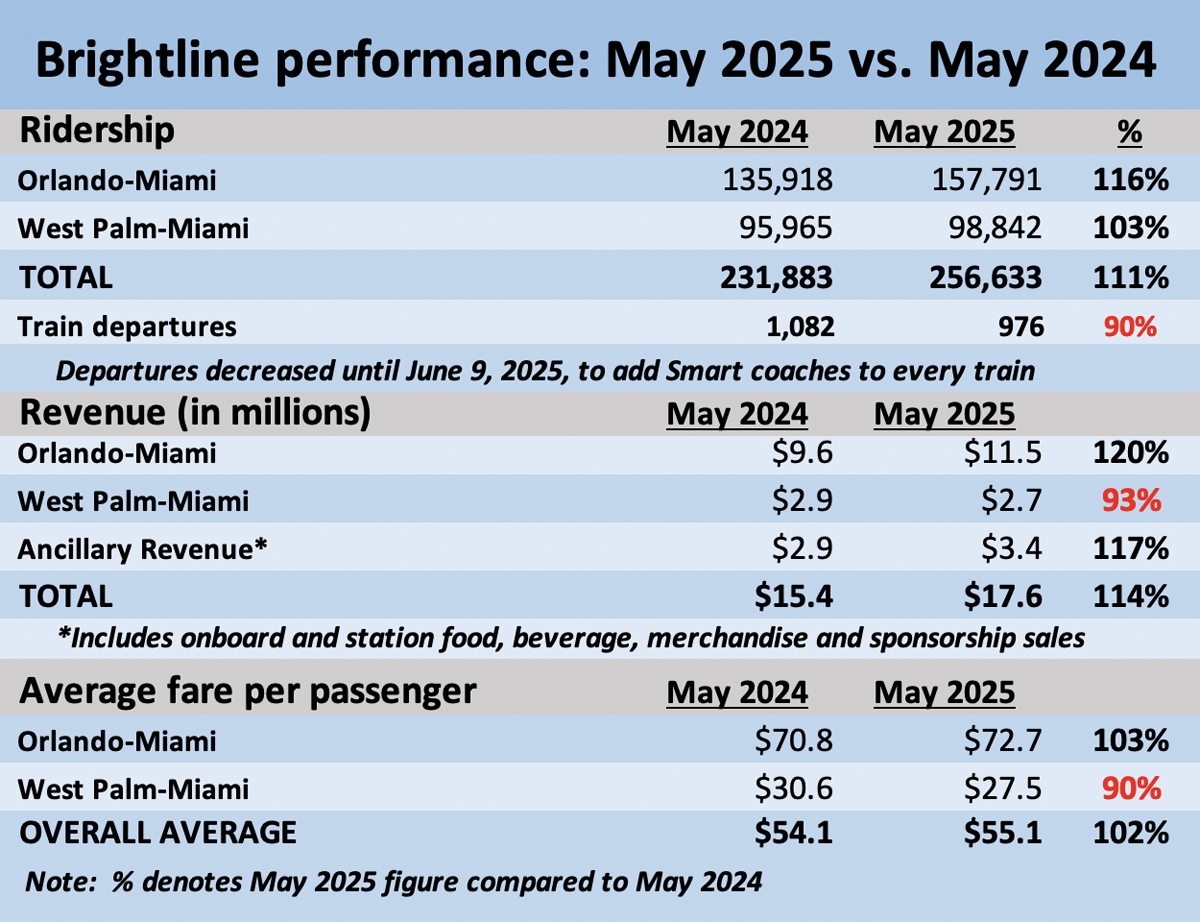
Ridership gained 11% with the additional seats, while total ticket and ancillary revenue rose 14% compared with the same month the previous year. All previous frequencies were restored June 9 after the final new Smart coaches entered service.
The increases in ridership with only limited “fare per passenger” increases reflect a renewed pricing strategy to recapture South Florida commuters. This is being done with 30-day passes in which the fare from Miami to West Palm Beach or Boca Raton ranges from $15 (40 rides), $26.50 (20 rides), and $30 (10 rides). The sliding scale is also available between other destinations, as outlined on the Brightline website. This pricing wouldn’t have been possible without the additional Smart capacity, a detail missed by financial analysts who complain about lower average fares.
The jury is still out on how successful the company will be in capturing a commuter market that is willing to pay more for the speed and comfort Brightline offers compared to the Tri-Rail option. Success so far has been driven by luring people out of cars that would otherwise be mired in excruciating I-95 or Florida Turnpike traffic jams. However, deliveries from Siemens of Premium class cars by the end of 2025 will boost overall per-passenger revenue once two of those with higher-priced seats can be offered per train.
Getting to Tampa
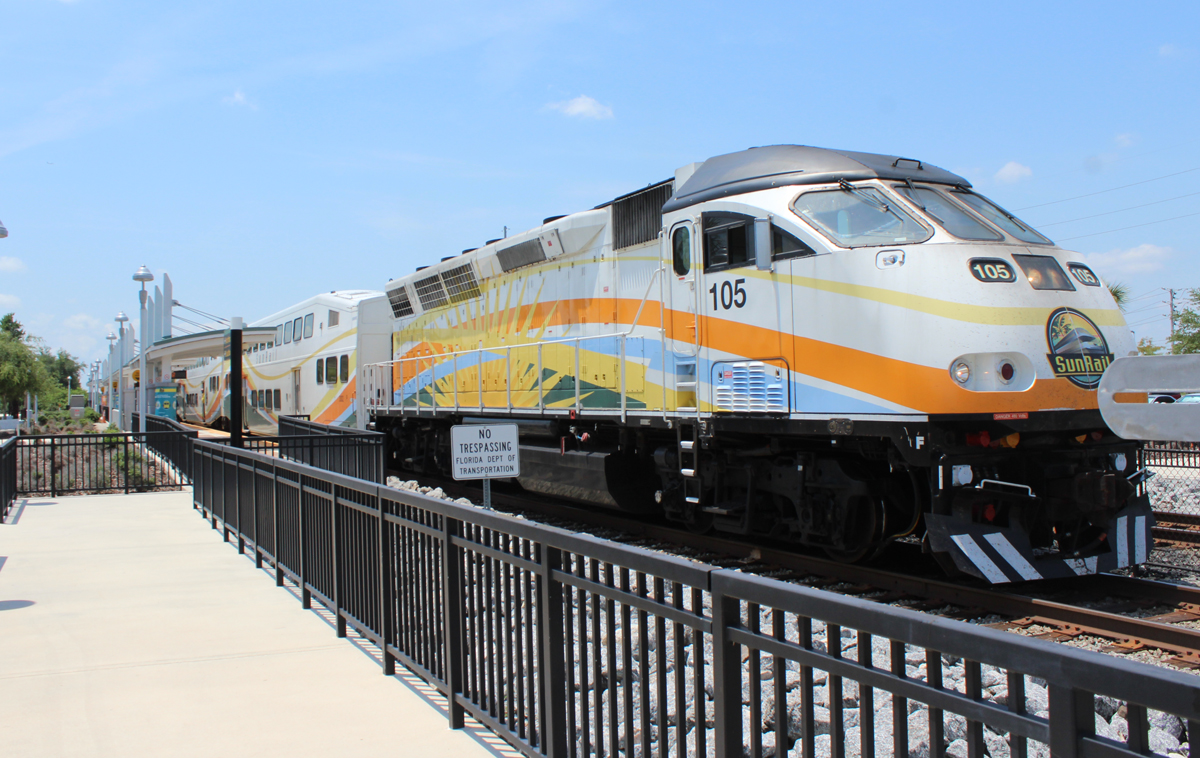
Extending trains past Orlando International Airport to Tampa, which the additional bonding authority will help facilitate, hinges on securing public financial support for Sunshine Corridor construction to the Orlando Convention Center and Interstate 4. Brightline’s request for additional bonding authority to move the Tampa expansion forward follows confirmation that the counties funding Orlando-area commuter operator SunRail value expansion to the airport.
Those counties recently approved funding matches that will allow a $6 million Florida Department of Transportation study to move forward to evaluate Sunshine Corridor route logistics and construction costs [see “SunRail agency approves …,” News Wire, April 30, 2025]. The results of that analysis will help determine the total cost of the joint Brightline/SunRail westward expansion.
The route to I-4 will follow existing Orlando Utilities Commission tracks out of the airport past Brightline’s maintenance facility to the north-south SunRail route (also used by Amtrak trains) north of the Meadow Woods station. The new grade-separated trackage, to be used by both SunRail and Brightline trains, would then parallel Florida Route 528 — the same highway Brightline follows between Cocoa and the airport — to I-4. After serving both the convention center and attractions, Brightline’s right-of-way would then head to Tampa in the median of I-4, where a two-track path for high-speed rail has been maintained by the Florida Department of Transportation since the 1990s. This sealed corridor trackage could accommodate trains at speeds up to 125 mph.
Plans for a Tampa terminus and a possible intermediate station have not been finalized and presumably would receive attention from funds raised by the additional bonding and other sources. A total cost for the expansion has not been estimated, but if the project was a highway, the necessary financial assistance would be paid for by the public.






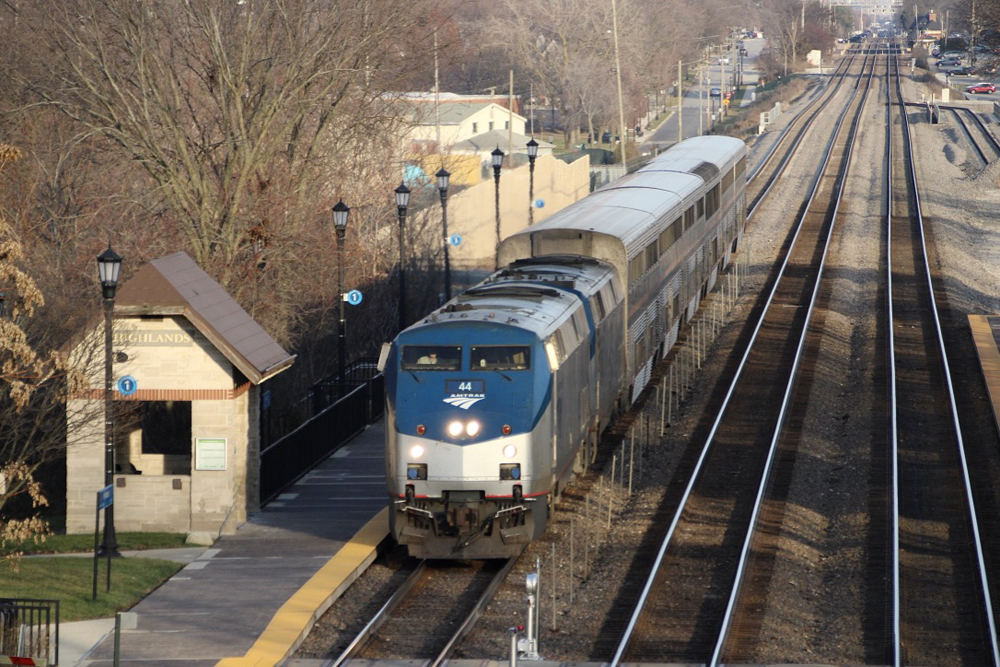
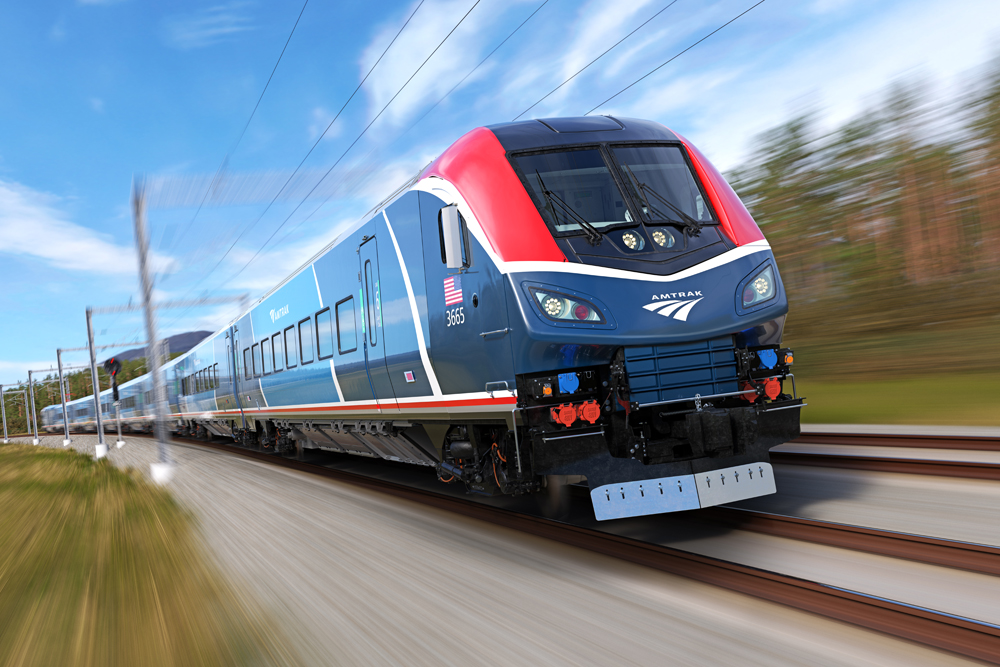
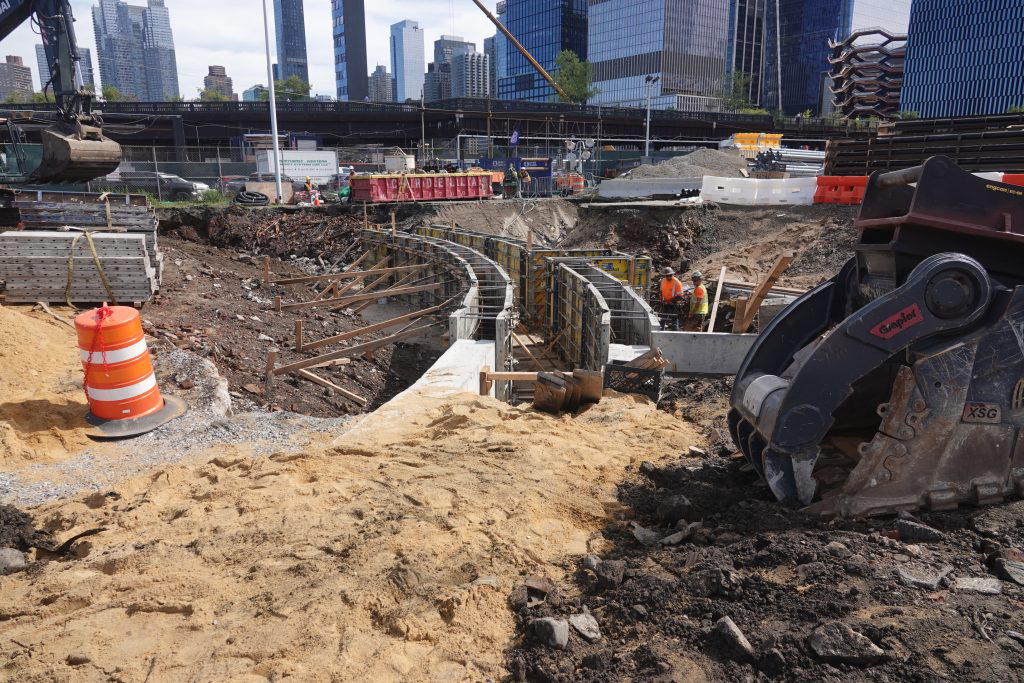
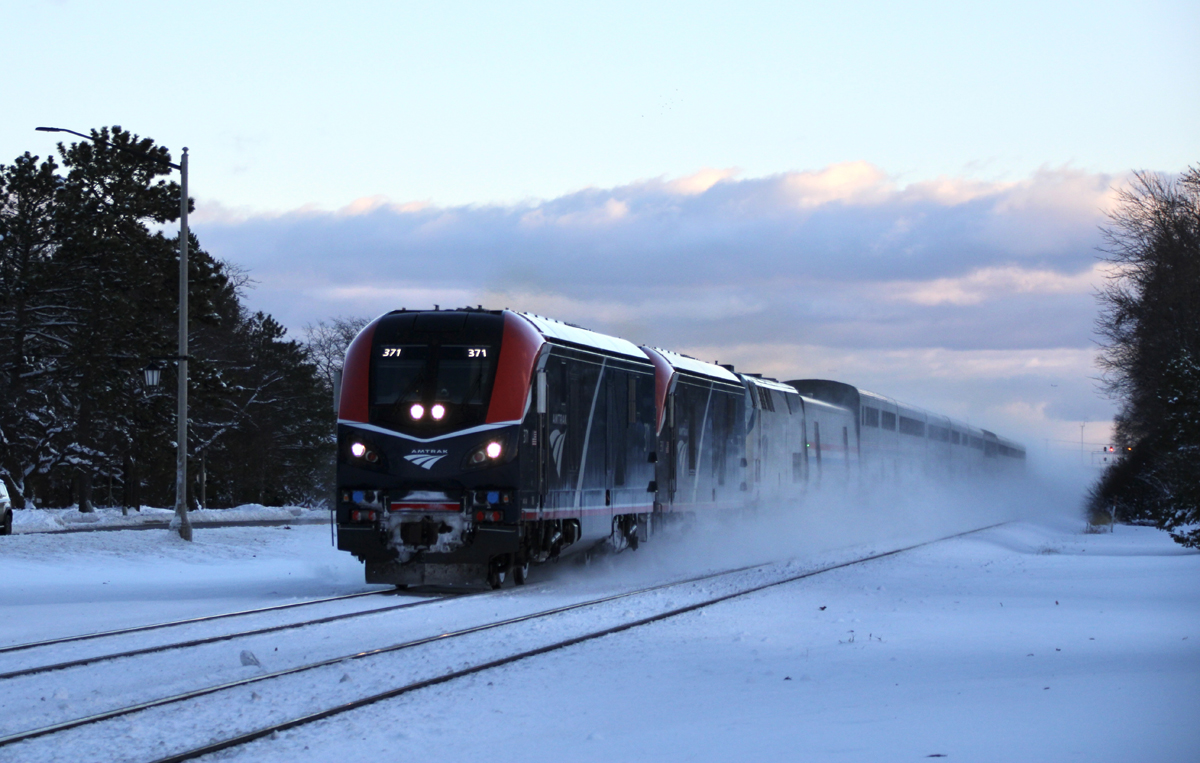
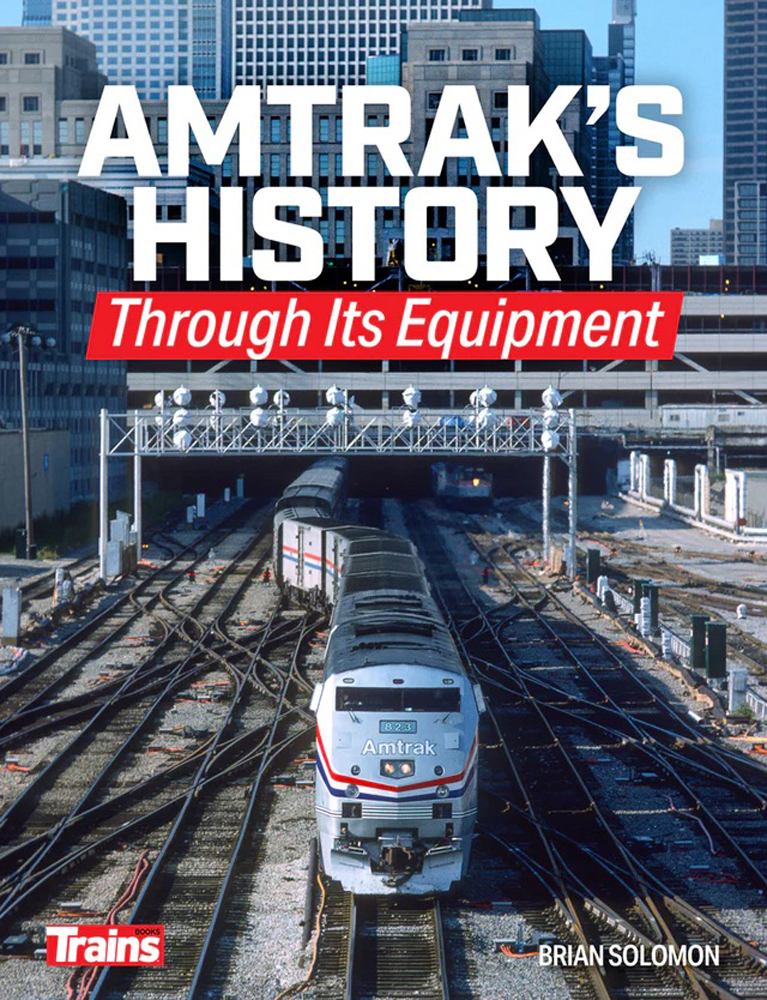


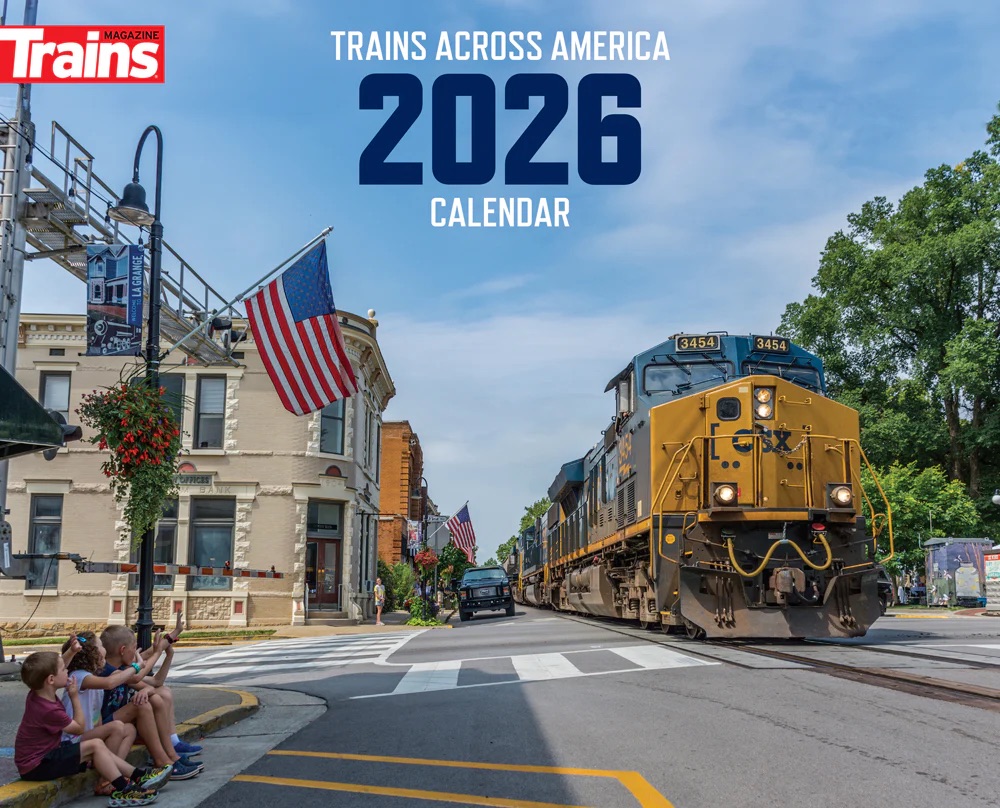
Let’s be honest… It’s probably true that many Tampa residents might prefer to drive to Orlando so they’d have their car with them, but many tourists and visitors would likely prefer to take the HST service and then rent a car or get an Uber to their destination. The related Brightline extension would certainly encourage leisure and business tourism to the connecting areas while minimizing road congestion… Remember that if Brightline’s Tampa-Orlando connection is completed, it could get Tampa inhabitants to Orlando in an hour rather than driving nearly ninety minutes on the interstate.
Dr. Güntürk Üstün
90minutes from Tampa to Orlando on the interstate? God luck with that.
Tampa is a large tourist attraction. People wouldn’t need to get a car if you take Brightline in the AM from Tampa Central and get off at either the future Kissimmee Station (Disney) or at the Sea World Station (Epic Universe).
Also a huge issue is non US drivers trying to reach their I-Drive hotels from the Disney parks between 5-7PM in their rental cars. Many of those drivers are not used to left hand drive in the US and move to the US “fast lane” which in a right hand drive highway is the slow lane.
So it creates these massive backups as they drive conservatively, not knowing they are causing a backup as people have to move to the right to get around them.
There have been accidents as families from the EU in their rental mini-van or SUV’s try to navigate across 4 lanes of traffic from the exit ramp to reach the farthest lane over, when they should have just stayed to the right.
With this deal, people can walk or shuttle over to the Kissimmee Station to take them up to the I-Drive district. (since Disney is now refusing to let it pass on their property).
Disney much prefers to use their diesel buses that circulate through all of the hotels for people to get to and from their parks.
Note that the public is invited to weigh in on this plan during a telephone conference call at 2 p.m. on Thursday, July 17. Here’s how you can access the telephone conference:
* Toll-free dial-in number: (833) 928-4609
* Meeting ID: 856 4507 6824
* Passcode: 358411
Dr. Güntürk Üstün
What has not been explained is why Brightline did not have more capacity one Orlando service started. Could it not have ordered more cars to begin when Orlando started? Have to wonder how many additional passengers it would get if Sun Rail serves the Orlando airport. My many persons I know all complain about the politics of no service. Parking at Orlando airport from reports I receive is oversold during higher travel times. + parking fees outrageous.
From everything seen access to Brightline at Orlando would be about the same amount of time if Sun Rail could be used.
The Sunshine Corridor project must see the light of day.
Dr. Güntürk Üstün
@ alan jones: The reason capacity got constrained was due to a last minute change in methods to open and close the draw bridge at Stuart. Due to an arm twist (and threat) at the last second by a US Rep from Stuart, the Coast Guard threw out the negotiated bridge schedule to appease the boating constituency.
This meant that trains from Orlando to Miami were getting held back longer waiting for the bridge to close. This meant less trains when it got into the West Palm-Miami commuter district. A side effect of this was that the more profitable seat was a passenger buying an Orlando-Miami fare. This meant that the seats were not available for booking by the time the train reached the commuter district. Brightline had no choice but to raise fares in the commuter district to make sure seats would stay available for Orlando boarders. Remember that once a seat is booked in West Palm, it can’t be booked back in Orlando. It sits empty when it leaves.
This meant to overcome the crunch at the bridge, Brightline had to spend additional funds to acquire more trainsets to fill the gaps south of Stuart.
All because 1 person decided to over rule a reasonable and data driven settlement between the Brightline and the Coast Guard. This decision had consequences down the line.
Do I sense double plus ungood duckspeak here? Seems that “private activity bonds” means public taxpayer financing. Also the Florida highway department pitched in by building the r/w at an increased cost compared to a standard freeway median.
I’m all for subsidized rail transportation (I ride Amtrak, METRA, Denver RTA and MBTA at taxpayer expense) but call it what it is.
It is too bad that this is not a government project because it would be way cheaper. Since this is for profit, one can imagine that it will cost too much. But, it might be worth it.
Dr. Güntürk Üstün
@Charles: Brightline already got a grant via the FRA after the PAB’s were issued. As for the PAB’s being a subsidy, well, hardly. PAB’s are for private projects that have a public value but are too large for banks to finance themselves. So the Florida Finance Authority reviews the projects public value and decides if they should get a municipal interest rate or a private market rate.
So Brightline *did* get a subsidy via the FRA, small compared to the overall project cost. It basically reimbursed them for their regulatory expenses.
As for I-4 and the median that was built for a future HSR, that was actually built due to a constitutional amendment in the Jeb Bush Administration that required all highway rehabs to include space for future HSR. The amendment was subsequently abolished, but the construction was well underway. Brightline does not get the ROW for free. It had to go through an RFP process and Brightline had to prove they could use it. Plus they will be paying FDOT rent to be there. Definitely not free.
@Dr Ustun: There is no way the state government could have built this as fast or as cheaply as Brightline did. Just the permitting process was much, much faster because they were a private, not a public enterprise. Fewer constituencies to please, fewer accommodations for special interests.
Charles, from a tax and investment standpoint. Private-Activity Bonds are treated as Municipal Bonds. The interest is tax-free income, except for taxpayers subject to AMT (which are much fewer thanks to the TJCA). Assuming Florida permits Brightline to issue them, FL taxpayers will not be on the hook in case of default. Because the FL DOT believes the project, if built, will provide a greater public-good (e.g., less traffic on I-4 & rental income for the R/W), they agree to “subsidize” the project’s financing, and thus this becomes a public-private partnership.
Gunturk,
In all my many years of experience working with USA governments at all levels, I’ve never seen one government project that wouldn’t have been done cheaper and faster by private sources. Even if the “private” would use union labor that’s still the case.
JOHN RICE — I get your point that Florida DOT is charging Brightline rent for the median improvements.
Which leads to this: the State of Florida fronts the massive capital investment for a company which, over the years, may or may not be able to pay the rent. The rent, if paid, may or may not be sufficient to cover capital recovery for the freeway improvements.
While I obviously haven’t seen the plans, I think we’re talking of multiples of $10 Million per lineal mile of centerline. This is of course what in my day in E-School was called a S.W.A.G., the initials for Scientific Wild (…..) Guess.